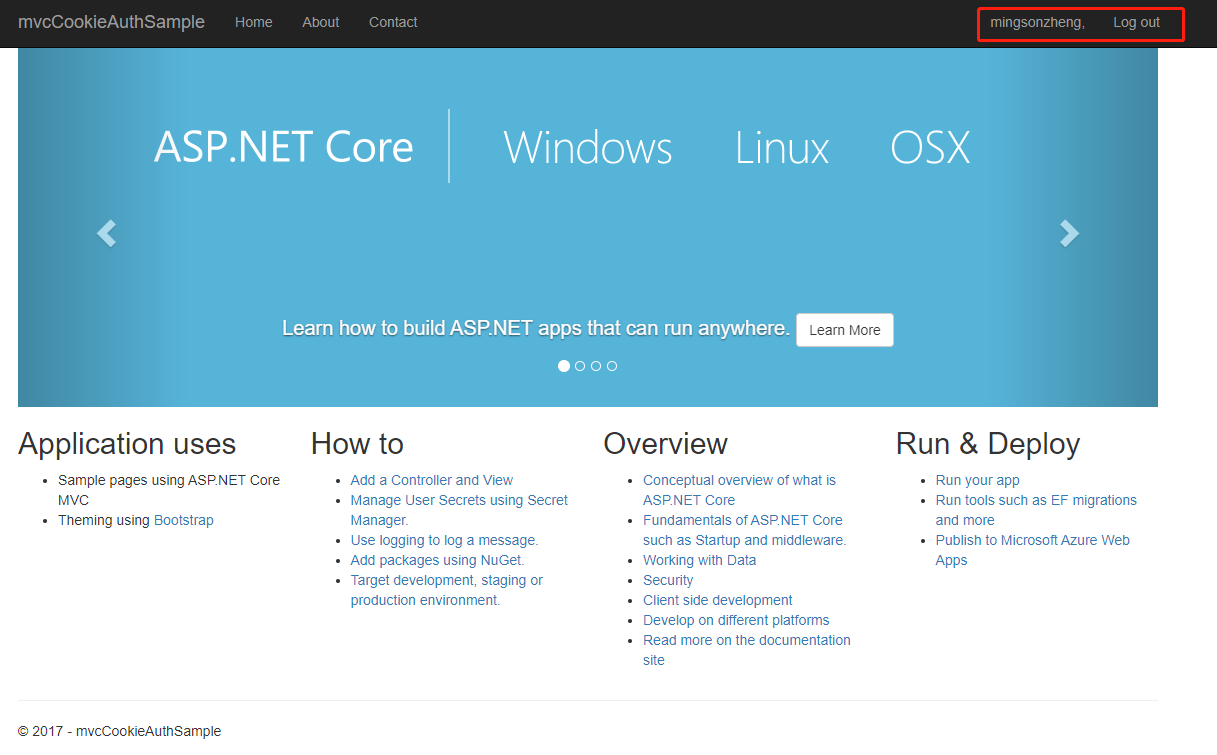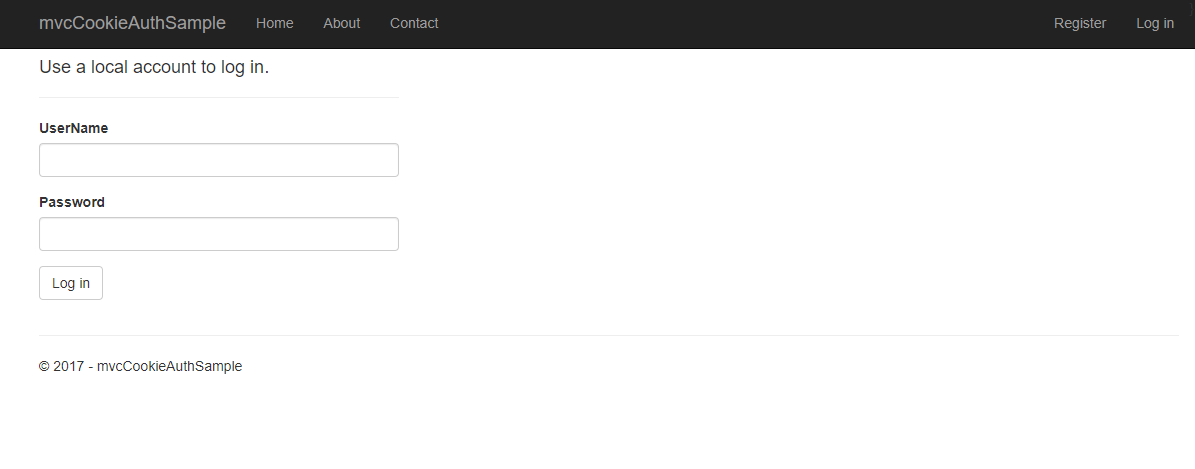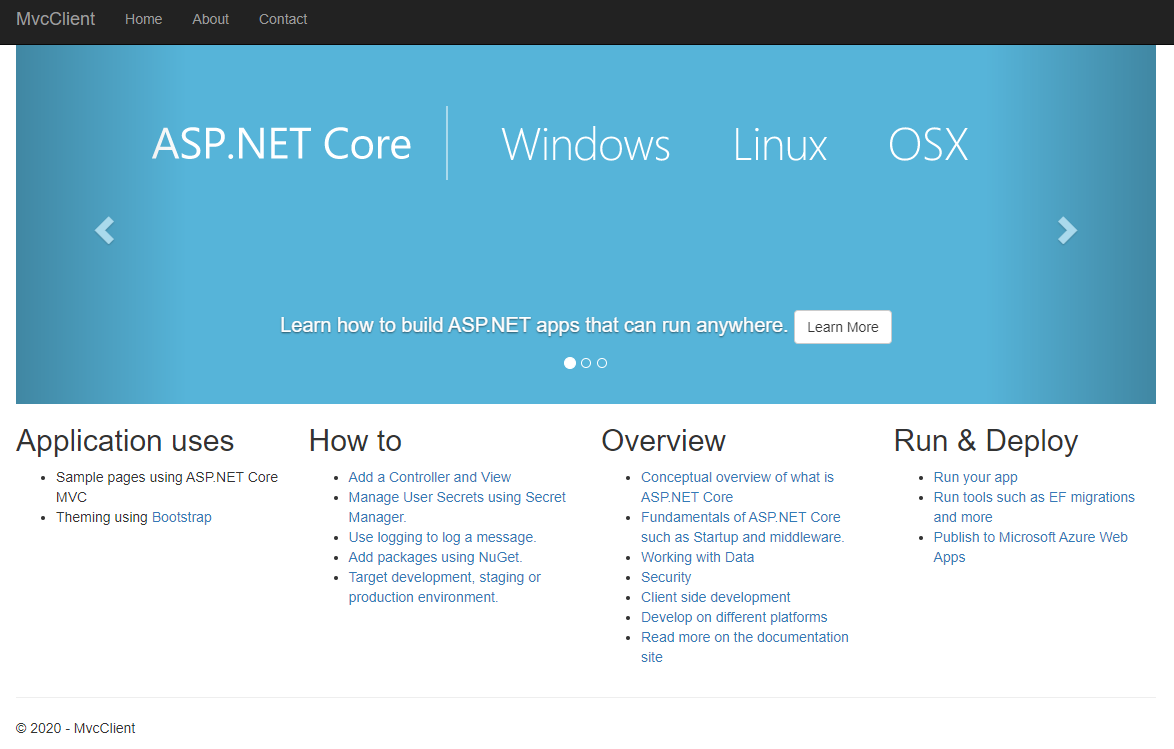任务16:oauth2 + oidc 实现 client部分
实现 client 之前启动一下上一节的 server,启动之前需要清除一些代码
注释 Program 的 MigrateDbContext
public static void Main(string[] args)
{
BuildWebHost(args)
//.MigrateDbContext<ApplicationDbContext>((context, services) => {
// new ApplicationDbContextSeed().SeedAsync(context, services)
// .Wait();
//})
.Run();
}
RegisterViewModel
[Required]
//[DataType(DataType.EmailAddress)]
//public string Email{get;set;}
public string UserName { get; set; }
启动程序,使用 Config 中的 TestUser 登录

登录成功,不过现在是在本地,接下来需要把它放到客户端里面
新建一个 Asp.Net Core MVC 网站 MvcClient
在 startup 的 ConfigureServices 中添加 Authentication
// This method gets called by the runtime. Use this method to add services to the container.
public void ConfigureServices(IServiceCollection services)
{
services.Configure<CookiePolicyOptions>(options =>
{
// This lambda determines whether user consent for non-essential cookies is needed for a given request.
options.CheckConsentNeeded = context => true;
options.MinimumSameSitePolicy = SameSiteMode.None;
});
services.AddMvc().SetCompatibilityVersion(CompatibilityVersion.Version_2_1);
services.AddAuthentication(options =>
{
options.DefaultScheme = "Cookies";
options.DefaultChallengeScheme = "oidc";
})
.AddCookie("Cookies")
.AddOpenIdConnect("oidc", options =>
{
options.SignInScheme = "Cookies";
options.Authority = "http://localhost:5000";
options.RequireHttpsMetadata = false;
options.ClientId = "client";
options.ClientSecret = "secret";
options.SaveTokens = true;
});
}
在 startup 的 Configure 中的 UseMvc 前添加 Authentication
app.UseAuthentication();
在 Program 的 CreateWebHostBuilder 中配置 Urls
public static IWebHostBuilder CreateWebHostBuilder(string[] args) =>
WebHost.CreateDefaultBuilder(args)
.UseUrls("http://localhost:5001")
.UseStartup<Startup>();
客户端设置为5001来启动,然后服务端设置为5000
mvcCookieAuthSample 的 Program
public static IWebHost BuildWebHost(string[] args) =>
WebHost.CreateDefaultBuilder(args)
.UseEnvironment("Development")
.UseUrls("http://localhost:5000")
.UseStartup<Startup>()
.Build();
修改服务端的 Config 配置跳转地址
public static IEnumerable<Client> GetClients()
{
return new List<Client>
{
new Client()
{
ClientId = "client",
AllowedGrantTypes = GrantTypes.Implicit,// 隐式模式
ClientSecrets =
{
new Secret("secret".Sha256())
},
RedirectUris = { "http://localhost:5001/signin-oidc" },
PostLogoutRedirectUris = { "http://localhost:5001/signout-callback-oidc" },
//AllowedScopes = {"api"},
AllowedScopes =
{
IdentityServerConstants.StandardScopes.Profile,
IdentityServerConstants.StandardScopes.OpenId,
}
}
};
}
客户端的 Controller 打上 Authorize 标签
[Authorize]
public class HomeController : Controller
修改客户端 launchSettings.json 中的 applicationUrl
"applicationUrl": "http://localhost:5001",
"sslPort": 0
启动服务端,客户端,可以看到跳转到登录界面

登录之后会跳转到 http://localhost:5001/

在客户端 About.cshtml 页面显示 identity 的 claims
@{
ViewData["Title"] = "About";
}
<h2>@ViewData["Title"]</h2>
<h3>@ViewData["Message"]</h3>
@*<p>Use this area to provide additional information.</p>*@
<dl>
@foreach (var claim in User.Claims)
{
<dt>@claim.Type</dt>
<dt>@claim.Value</dt>
}
</dl>
启动程序,跳转之后,点击 About 进入 About 页面

主要返回了服务端 Config 中配置的信息
public static IEnumerable<IdentityResource> GetIdentityResources()
{
return new List<IdentityResource>
{
new IdentityResources.OpenId(),
new IdentityResources.Profile(),
new IdentityResources.Email(),
};
}
课程链接
http://video.jessetalk.cn/course/explore

本作品采用知识共享署名-非商业性使用-相同方式共享 4.0 国际许可协议进行许可。
欢迎转载、使用、重新发布,但务必保留文章署名 郑子铭 (包含链接: http://www.cnblogs.com/MingsonZheng/ ),不得用于商业目的,基于本文修改后的作品务必以相同的许可发布。
如有任何疑问,请与我联系 (MingsonZheng@outlook.com) 。
